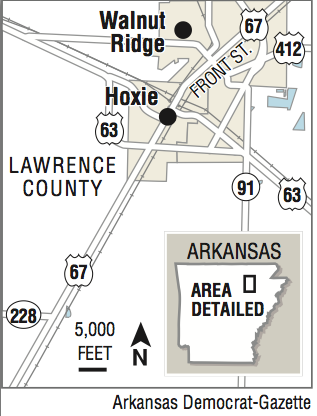A week after voters in Walnut Ridge and College City in Lawrence County decided to merge, city officials in Walnut Ridge and neighboring Hoxie are discussing consolidating, as well.
A Walnut Ridge-Hoxie merger has been discussed for decades, and it's an emotional issue for some who fear that joining the two cities will cost Hoxie its identity, but the cities' leaders are considering the economic impact of such a merger.
"It would put the community at over 8,000 people," Walnut Ridge Mayor Charles Snapp said of the cities merging. "That has a lot of potential."
In a May 10 special election, voters in Walnut Ridge and College City approved merging the two towns effective Jan. 1, which will create a city of more than 5,000 people. That may have revived the debate about Walnut Ridge and Hoxie consolidating, Snapp said.
"That was a no-brainer to join with College City," he said. "We were already taking care of the sewer, police protection, water and mosquito spraying there.
"There are a lot more things to look at with Hoxie."
For years, local officials have discussed merging the two cities to save on duplication of fire, police, sewer and other services. Walnut Ridge, with a current population of 4,766, shares a border to the south with Hoxie, population 2,719. Midway Road separates the cities' limits.
U.S. 67 is the main north-south highway through the heart of both cities, and its motorists aren't likely to notice where one city ends and the other begins.
In talks 25 years ago, Hoxie residents balked at consolidating, fearing that Hoxie's school district would then consolidate with Walnut Ridge and Hoxie would lose its identity.
Also, there's been some animosity between the two cities over the years.
In 2000, Hoxie residents voted to annex 2,000 acres south of the town along U.S. 63, hoping that when highway officials opened the new four-lane U.S. 67 through the area, the land would be lucrative as locations for gas stations, shops and hotels.
A few weeks later, Walnut Ridge voters decided to annex the same tract of land, creating a tug-of-war of sorts between the cities.
In April 2000, about a dozen residents who lived in the disputed tract cast the tie-breaking votes, deciding to annex with Walnut Ridge.
"It's still a sore spot for some," Hoxie Mayor Lanny Tinker said. "Emotions were high. Before that, none of Walnut Ridge's turf ran south of the railroad [which splits the two towns]."
And it wasn't Walnut Ridge's first land dispute.
Hoxie was founded because of a Walnut Ridge land dispute. In 1875, when the Memphis Railroad began laying train tracks in Lawrence County, Walnut Ridge officials did not want to give up land for the railroad, historians said.
So, the railroad used unincorporated land south of Walnut Ridge and tentatively called that area "Owl City." The name was changed to Hoxie soon after, when a railroad worker named Hoxie arrived there to install a railroad switch.
Tinker said he understands the economics of a potential merger but his town "is not broke." Hoxie has a surplus of $602,000, he said.
"The truth is, though, cities of our size don't know what the future is," Tinker said. "We don't know how much money we may need later. We don't want to shut any doors to the future, but at the same time our town is financially stable now."
Walnut Ridge aldermen formed a committee Tuesday evening to investigate the possibility of a merger. Committee members include a retired military man, an insurance agent, the Walnut Ridge fire chief and the wife of the Williams Baptist College president.
"We want to look at the cost-effectiveness of this," Snapp said. "If you're buying a house with sewer problems, water leaks and cracks in the driveway, would you not get the cost of repairs before buying that house?"
Both mayors said they don't expect a merger anytime soon, but they want to look at the variables involved.
"We need to take some time with this," Tinker said. "We need to do as much as we can to be unified.
"It's going to play extremely slow. We have the opportunity, though, to change our sales tax base if we do this."
Snapp said his committee will investigate the various costs of merging -- including what needs to be done to create equal fire protection ratings for both cities, whether the two water systems can work together, and whether police and fire services can join.
"But it's not up to the City Council and mayors of the towns," Snapp said. "Ultimately, it's up to the voters. If they call for an election, I want to be ready and know what we are facing.
"We are taking steps in the right direction. We need to be more regional in order to attract new business. We have to realize we all live in Lawrence County, and we need to work together.
"I want to open the door and take a peek before we decide on anything."
State Desk on 05/18/2016

